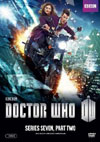DVD Extras for this story on the 15-episode box sets include:
Amongst the cons is the fact that this looks like it's going to be a formula bottle show with a solitary alien menace gradually picking off the crew one by one until a solution is put into place at the last minute. Thankfully, this particular story delivers a lot of enjoyable character moments, surprise twists, and more sensible unpredictable dynamics, but it's hard to anticipate most of the good stuff before it happens. The narrative doesn't really draw the viewer along like so many other stories this season. I think the setting will have to take a certain amount of the blame. An early 80's nuclear submarine sounds cool at first, and it is cool that it has the cultural intrigue of being a Russian sub instead of an American one. But when the setting is as confined as this, one can feel the limitations of where the story might be allowed to go. I think the alien's abilities to sneak around unseen by the crew also suffered when it was realized that each compartment would be sealed off with only very small obvious hatches between them and no man-sized ductwork for it to crawl through. This is a problem that the director doesn't seem to have been able to get around effectively. Without this story being able to expand its territory, and telegraph the possibility to the audience early on, our excitement level is somewhat cramped.
Ice Marshall SkaldakOf course one of the big plusses that this story has going for it is that another major race of Doctor Who aliens makes its comeback for the New Millennium version of the show. In fact, we haven't seen the Ice Warriors since the Jon Pertwee years, and knowledgeable fans have been anticipating their reappearance since it first seemed time for them during the 2009 specials, so this return is long overdue.The costume is quite faithful to the most definitive one from the late 60's and early 70's, slightly updated to more clearly define which aspects are clothing and which are organic. But in long shot or silhouette, you would be hard pressed to tell the difference. Nicely balanced. All is peachy until Skaldak introduces himself and we learn that his rank is that of a Grand Marshall... and then we veteran fans begin to wonder if he shouldn't be wearing the more slender Ice Lord uniform that Alan Bennion was always seen in (plus extra bling on the helmet) instead of the standard foot-soldier outfit seen here. Whoops.
Overall I think the story is smart to reveal our Ice Warrior early on, and then move fairly quickly towards new dynamics. Our Ice Warrior comes out of his suit, which has never been done before on the show. Gradually more and more is revealed, saving the full-on decently lit reveal of his face for the climax of the show. All good in theory, but I confess that a naked Ice Warrior skulking around a submarine isn't really as exciting as you might think. His fingers seem a bit too long and thin considering the clunky claw gloves we've seen up to this point, and it's bizarre to see so many Humans nicely holding still while the fingers reach down from the rafters to play endlessly with their faces. Thankfully, Skaldak's face is a triumph of CGI design and animation, and it will be easy enough to take that image back with us each time we view their previous adventures. That alone may make "Cold War" worth the price of admission. The writing of this story also does a lot to flesh out the Martian culture, whether it comes from Skaldak's personal backstory or from the Doctor's abbreviated history lessons. We probably get more good stuff in these 43 minutes than we've had in all four previous Ice Warrior stories all put together. And a very critical move happened at the beginning of this story. Now that the Peladon stories have proven the existence of a noble side to these creatures, the Doctor makes the effort to figure out the disposition of today's example, instead of jumping to conclusions and an antagonistic posture. This is a move that escaped "Mission to Magnus" in its rough-script-turned-novel form, a story that would have seen the Ice Warriors return in the mid-eighties if its particular season hadn't been cancelled. Of course, a few Russian crewmembers do jump to conclusions, and the usual misunderstanding triggers the rest of the plot.
SubmergenceOne scene that really did rub me the wrong way early on was that of the Doctor and Clara's arrival in the midst of an emergency. I find it nearly impossible to follow the dialogue with so much noise and frenzy going on - it really just does more to grate on the nerves than create any sense of excitement. Secondly, having the entire cast soaked from all that water right from the beginning, and knowing that the story probably won't give them a chance to dry off properly at any point, really works to send me away from their situation instead of drawing me in. I think a flood like this should be saved for the end of the story, if used at all. That way, perhaps we might get some sense of escalating tension when we see water dripping in larger and larger quantities as the show progresses, which actually might have been the case if the script had been followed more diligently. On the commentary, Gatiss kindly gives all credit for the opening flood to director Douglas MacKinnon. As it stands, after that big torrent in the sub's most sensitive control center at the beginning (which quickly amounts to no big deal), there's no real sense of danger from further leaks later on.Most of the sub's crew all wind up feeling like one great homogenous collection of men. Only two characters really stand out - the very distinctive looking captain of the ship, and the unmistakable figure of David Warner playing Professor Grisenko. I've been a fan of Warner's since "Tron" and "Time Bandits", which just barely predate my becoming a fan of Doctor Who. Warner seems to have fun here playing with the quirks and character twists that Gatiss wrote for him, but he seems to be a bit underutilized in the story, as was the case in Star Trek feature films five and six. Though Gatiss's characters are almost always fun to watch, there remains a sense that he's adding and refining their traits willy-nilly, without a vision of where they are going or why they've been selected to participate in his stories. Perhaps we simply don't quite get enough of Grisenko's desire to investigate his find scientifically, or enough of him responding to the fact that his shipmates are paying with their lives. That said, what we do get with his music obsession is a worthwhile touch, showcasing a different side of Warner's talents, which I gather was partly the point. Nice. Of course, I get that there's also a very war-mongering first officer here, but it's very easy to lose track of this character. As you can pretty much predict going into this adventure, there will be the usual 1980's message that the two halves of the world should not nuke each other, and yes this threat does fuel the climax of the show. To me, it does feel like obvious, tired fare. But perhaps there still are people out there who stand to benefit from having this message repeated to them yet again?
And an added bonus is that we finally get to see one of the Ice Warriors' spacecraft, which is an enjoyable touch. Somehow, their previous four stories had all managed to miss out on an obvious effect. There's a parallel here with "Victory of the Daleks" (story no. 210) in that I think all of us fans really wanted a more substantial and complex story featuring this particular race, and wound up settling for a simpler re-introduction teaser here, wishing the cameras and the narrative could follow the departing aliens to new worlds where better adventures await. But this story is better than Gatiss's Dalek adventure in the sense that it does feel much more complete, no real loose ends left dangling. And in production terms, I think this one was all about getting the suit and the alien's design right, so that these elements are already "in the bag" when they come to design the rest of the world that the Martians live and work in. Lastly, I do scratch my head at the use of the HADS system here. Back in "The Krotons" (story no. 47), at least it seemed that it was a helpful function for both the TARDIS and her passengers. Here, not so much. But this all works believably for story purposes until we learn that the vehicle has gone all the way to the South Pole. This is played for laughs, but it's not all that big a laugh. Plus, I seriously doubt that the captain of a damaged submarine would agree to travel that far on the spot, and a closer, more believable destination for the TARDIS should have been selected.
International Titles:Deutsch: "Kalter Krieg"Magyar: "Hideg Háború"Français: "Destruction mutuelle assurée"Русский: "Холодная война"Italiano: "Guerra fredda"This story has become available on DVD and Blu-ray.
This story is also available in an 8-episode volume with minimal extra features. The U.K. version also includes the episode "The Snowmen"; North American versions do not. Click on the Amazon symbol for the location nearest you for pricing and availability:
Comments on this article are welcome. You may contact the author from this page:
|
|||||||||||||||||||||||||||||||||||||||||||||||||||||||||||














